East Javanese Tamarind Soup Recipe is one variant of tamarind soup originating from the East Java region. The difference between East Javanese Tamarind Soup and tamarind soups from other regions lies mainly in the composition of the spices and additional ingredients.
The cooking method and the taste are not significantly different. It retains the sweet, sour, spicy, and refreshing flavors. One distinctive ingredient of East Javanese Tamarind Soup is the “timun krai” cucumber from Banyuwangi, which is said to be available only during the month of Ramadan. Curious about the taste of East Javanese Tamarind Soup? Let’s explore the simple recipe below!
How to Choose “Timun Krai” Cucumber
Krai cucumber is a type of cucumber with a distinctive aroma and thicker flesh compared to regular cucumbers. Interestingly, this fruit is only cultivated by farmers in the Banyuwangi region as the Ramadan season approaches. The goal is to preserve the uniqueness of the krai cucumber itself. The price of krai cucumber is only IDR 6,000 per 250 grams.

Here are several ways to find high-quality krai cucumber as an ingredient for the East Javanese Tamarind Soup recipe:
- Choose krai cucumbers that are wide or large in size.
- Ensure they have a uniformly elongated and slender shape.
- The skin color of good krai cucumbers is generally dark green or light green.
- Select krai cucumbers that have white spots all over the surface of the skin.
- Try pressing the krai cucumber; make sure to choose one with firm flesh texture, indicating that the krai cucumber is sweet-tasting and still very fresh.
Tips for Enhancing the Flavor of East Javanese Tamarind Soup Recipe
- Add Salted Fish or Meat: To enrich the flavor of your tamarind soup, add broth from salted fish or meat. Simply include pieces of salted fish or meat into the boiling broth while the tamarind soup is still cooking.
- Use a Generous Amount of Spices: When making tamarind soup, pay attention to the spice measurements. It’s advisable to use a generous amount of spices when preparing tamarind soup, as it typically involves a substantial amount of broth. This helps avoid blandness in the soup.
- Boil Each Ingredient According to Its Type: When applying the East Javanese Tamarind Soup recipe, pay attention to each ingredient you add to the soup. Introduce vegetables starting from the ones with the firmest texture and longer cooking times, such as sweet corn. This ensures that the vegetables cook perfectly, and the tamarind soup’s flavor seeps into them adequately, preventing any overly mushy or overcooked textures.
- Use Bay Leaves and Galangal: When making tamarind soup, you’ll need specific spices to enhance the flavor. Ingredients like shallots, candle nuts, shrimp paste, chili, and tomatoes are crucial. Don’t forget to add bay leaves and galangal to create a tamarind soup with an enticing aroma.
- Add Tomatoes or Bilimbi: The tangy and fresh taste of tamarind soup comes from tomatoes or bilimbi. Therefore, it’s essential to add slices of tomatoes or bilimbi to the tamarind soup. Rest assured, the freshness of your homemade East Javanese Tamarind Soup will burst in every spoonful.
- Use Fresh Ingredients: The freshness of each ingredient significantly impacts the taste of tamarind soup. It’s recommended to use fresh ingredients to create a delicious and safe-to-consume tamarind soup. Using stale ingredients may lead to a quicker spoilage of the soup.
Simple Yet Delicious East Javanese Tamarind Soup Recipe
Ingredients
Main Ingredients
- 150 g beef for rawon
- 1 sweet corn
- 2 krai cucumbers
- 1 bunch of long beans
- 2 bunches of water spinach
- 100 g peanuts
- 3 red tomatoes
- 50 g raw tamarind
- 3 bay leaves
- 1 piece of galangal
- 1.5 tbsp salt
- 5 tbsp sugar
- 1/2 tsp broth powder
- 2600 ml water
- 5 g fried shallots
Ground Spices
- 60 g shallots
- 3 cloves garlic
- 6 roasted candlenuts
Instructions
- Cut the long beans, krai cucumbers, tomatoes, and beef into pieces.
- Blend the shallots, garlic, and candlenuts with a little water until smooth.
- Heat 2500 ml of water in a pot, then add the beef pieces. Cook until boiling.
- Add the peanuts, sweet corn, bay leaves, and galangal. Cook until it boils again.
- Add the blended spices and krai cucumbers. Ensure the krai cucumbers are not bitter to avoid ruining the flavor. Cook until it boils again.
- Add the tamarind, tomatoes, salt, sugar, and long beans. Stir well and cook until the vegetables are tender.
- Once the tamarind is cooked, remove it from the broth, break the skins, and return them to the broth.
- Add the water spinach and broth powder. Stir well and cook until all the vegetables are done. Adjust the seasoning to taste.
- Remove from heat and serve with a sprinkle of fried shallots.





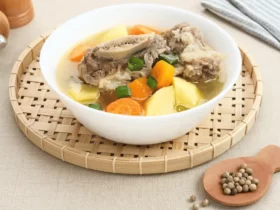



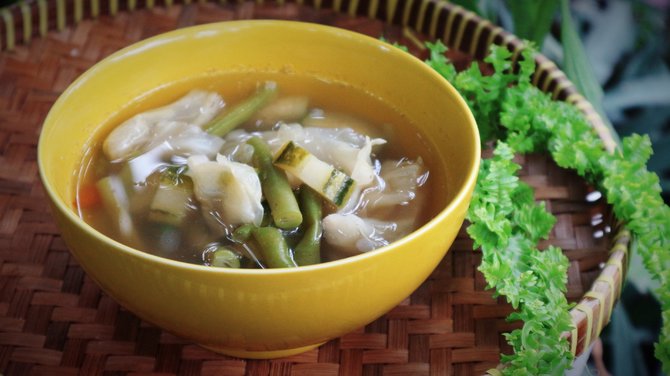
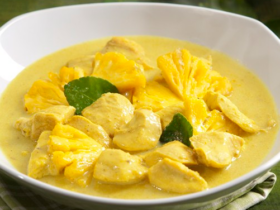



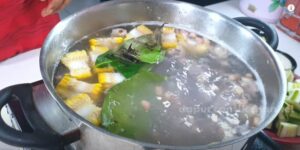

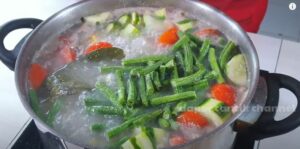
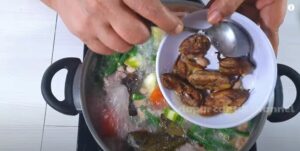
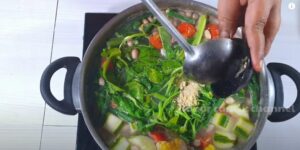





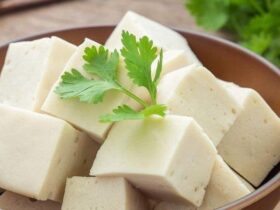
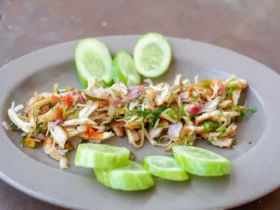
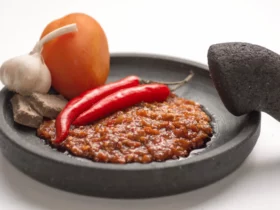
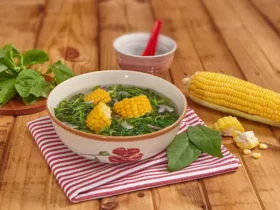
Leave a Reply